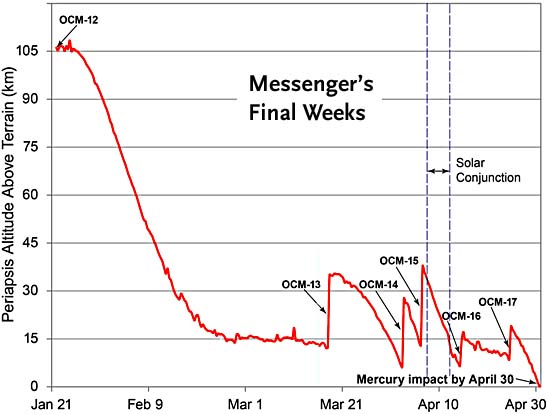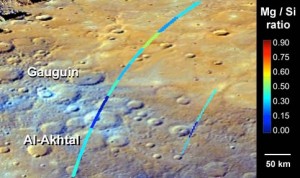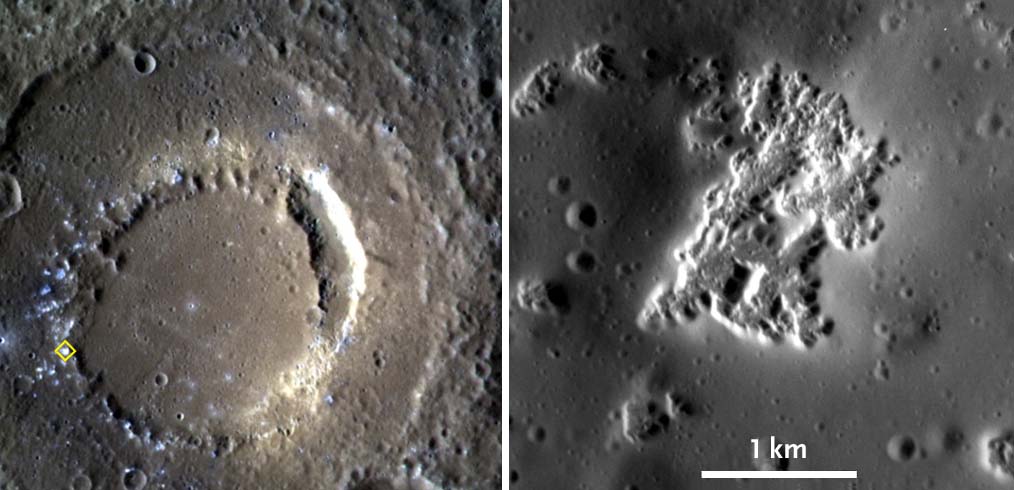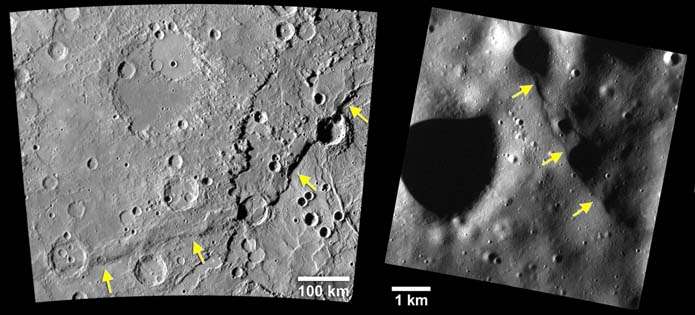With just weeks left before it crashes into its host planet, NASA's Messenger spacecraft is making the most of its extremely low altitude and finding that Mercury isn't a completely dead world.
There's been so much planetary exploration going on — from Chang'e 3 on the Moon to Dawn reaching Ceres to New Horizons readying for its historic Pluto flyby — that we tend to overlook some of the spacecraft still doing their thing around other worlds. One of those is Messenger, which tomorrow celebrates its fourth anniversary of entering orbit around Mercury. (That event wasn't beginning of the planet's reconnaissance, however, as the spacecraft had already zipped by at close range three times in 2008 and 2009.)

NASA / JHU-APL / Carnegie Inst. of Washington
Messenger's work is nearly finished. Fuel reserves are extremely low, and in a matter of weeks ground controllers will no longer be able to keep the craft's highly elliptical orbit stabilized. In fact, due to gravitational perturbations from the Sun, Messenger keeps edging closer and closer to the Mercurian surface. Only occasional boosts from the craft's thrusters are preventing an outright collision.
"We only have about 6 weeks to go in the mission," project scientist Sean Solomon noted during a press briefing yesterday. Five more thruster firings are planned. "We'll exhaust every last kilogram of propellant," Solomon vows, even expelling the helium used to pressurize the fuel in an effort to keep Messenger going. With luck, the end won't come until around April 30th. Then the golf-cart-size, half-ton craft will slam somewhere into the planet's mid-northern hemisphere.
But for now, the spacecraft continues to return abundant results. In fact, Messenger's "low-altitude campaign," which has been ongoing since last April, allows the craft's eight experiment teams to make observations far more detailed than those acquired earlier in the mission. These close passes benefit its camera, of course, but it's also a boon to the elemental assays made using the X-ray, gamma-ray, and neutron spectrometers on board. These devices can't be pointed — they "see" a very wide swath of the surface as a single pixel. So the closer Messenger comes to the surface, the smaller the patch of Mercurian they sample.
Complex Geochemistry

NASA / JHU-APL / Carnegie Inst. of Washington
Visibly, there's not much variation on the planet's surface. Colorations are subtle, suggesting that the planet lacks any distinct changes in regional geochemistry. But a different picture has emerged thanks to the high-energy spectrometers. For example, the distribution of magnesium (common in rock-forming minerals) varies wildly from place to place. In some locales it's as common as silicon, but in "fresh" exposures near young craters the magnesium signal nearly disappears.
One of the fundamental questions about Mercury is how it attained its unique overall composition — a disproportionately huge iron-rich core surrounded by a relatively thin silicate exterior. Messenger scientists had hoped that getting a handle on the surface composition would provide strong evidence for one of a few different ideas about how Mercury became the "Iron Planet." But at a briefing yesterday discussing recent Messenger results, geochemist Larry Nittler admitted, "I would argue that we still don't know the answer to that question a whole lot better than we did before we went into orbit."
The problem isn't a lack of data but rather a lack of detailed modeling, he explains. One oft-discussed idea is that a giant impactor smashed into young Mercury and stripped away most of its crust and mantle, leaving behind that giant cannonball of a core and not much else. Such a blast should also have bled off virtually all of the "volatile" elements (those with low melting points), such as sulfur, sodium, and potassium. Yet the Mercurian surface exhibits an abundance of volatile elements — and yet very little iron — leaving geochemists like Nittler scratching their heads.
Strange Surface Features
Imaging scientists are also getting an eyeful from the lower orbit, and the spacecraft's camera has been recording some key targets with resolutions of just a few meters per pixel.
Closer scrutiny is paying big dividends concerning the puzzling "hollows" seen early in the mission. Usually brighter than their surrounding and often confined to the floors of impact craters, these tight clusters of small pits are now being seen extremely well — in some cases with 50 times better resolution than early views had. The hollows inside Scarlatti basin, for example, are all a few tens of meters deep. "They grow and ultimately stop growing," observes David Blewett, a researcher at Johns Hopkins University's Applied Physics Laboratory.

NASA / JHU-APL / Carnegie Inst. of Washington
The emerging consensus is that some compound in the near-surface rocks, perhaps a type of sulfide, is vaporizing away once it gets exposed to the intense sunlight, radiation, and incessant bombardment from micrometeorites at the surface. As it escapes to space, holes are left behind. Moreover, the new close-ups show that, unlike the terrain surrounding them, the hollows exhibit very few impact craters. So they've not been there very long, geologically speaking. Blewett thinks they must be "younger than a few tens of millions of years and might well still be actively forming today."
Meanwhile, Thomas Watters, a researcher at the Smithsonian Institution's National Air & Space Museum, has been keeping track of little fractures in the planet's crust. Mercury is scarred by some truly big cracks, some hundreds of kilometers long. These thrust faults formed eons ago as the planet cooled and gradually shrank in volume. The circumference shrank too, causing the already-solid crust to crack and crumple. (Imagine what happens to the skin of a apple as it gradually dries out.)

NASA / JHU-APL / Carnegie Inst. of Washington
Recently Watters and others have noticed plenty of smaller compression fractures across the surface, many less than 10 km long and only tens of meters high. As with the hollows, these mini-fractures appear to have formed quite recently — "so young," Watters notes, "that they're probably forming today."
Yesterday's briefing also addressed the deposits of water ice that lie at the permanently shadowed bottoms of craters near the planet's north pole. In some cases, the ice might actually be exposed, but elsewhere researchers believe it's covered with a dark, organic-laced protective veneer. Messenger's extended mission has allowed scientists to take intentionally overexposed images of these always-dark crater floors, with surprising results. The dark veneers typically have a sharp boundary, observes Nancy Chabot (JHU-APL) — too sharp to have been around for along time. "This must either be young or an ongoing process," she explains.
Next Up: BepiColombo
Even after Messenger's impending demise, the mission team has plenty of stockpiled observations to work though and the the scientific hits should keep on coming for a while. Geochemists are also looking forward to getting results from the European Space Agency's BepiColombo, a follow-on orbiter scheduled to launch in 2017 and arrive at Mercury in 2024. Its 11-instrument payload includes one key experiment that Messenger lacks: a spectrometer attuned to thermal-infrared wavelengths. Its results should reveal the surface's true composition — and, with that, likely the key to understanding what happened to Mercury all those eons ago.
Thanks to Messenger's extensive reconnaissance, you can now explore this mysterious planet yourself with Sky & Telescope's exclusive Mercury globe.
 0
0
Comments
You must be logged in to post a comment.